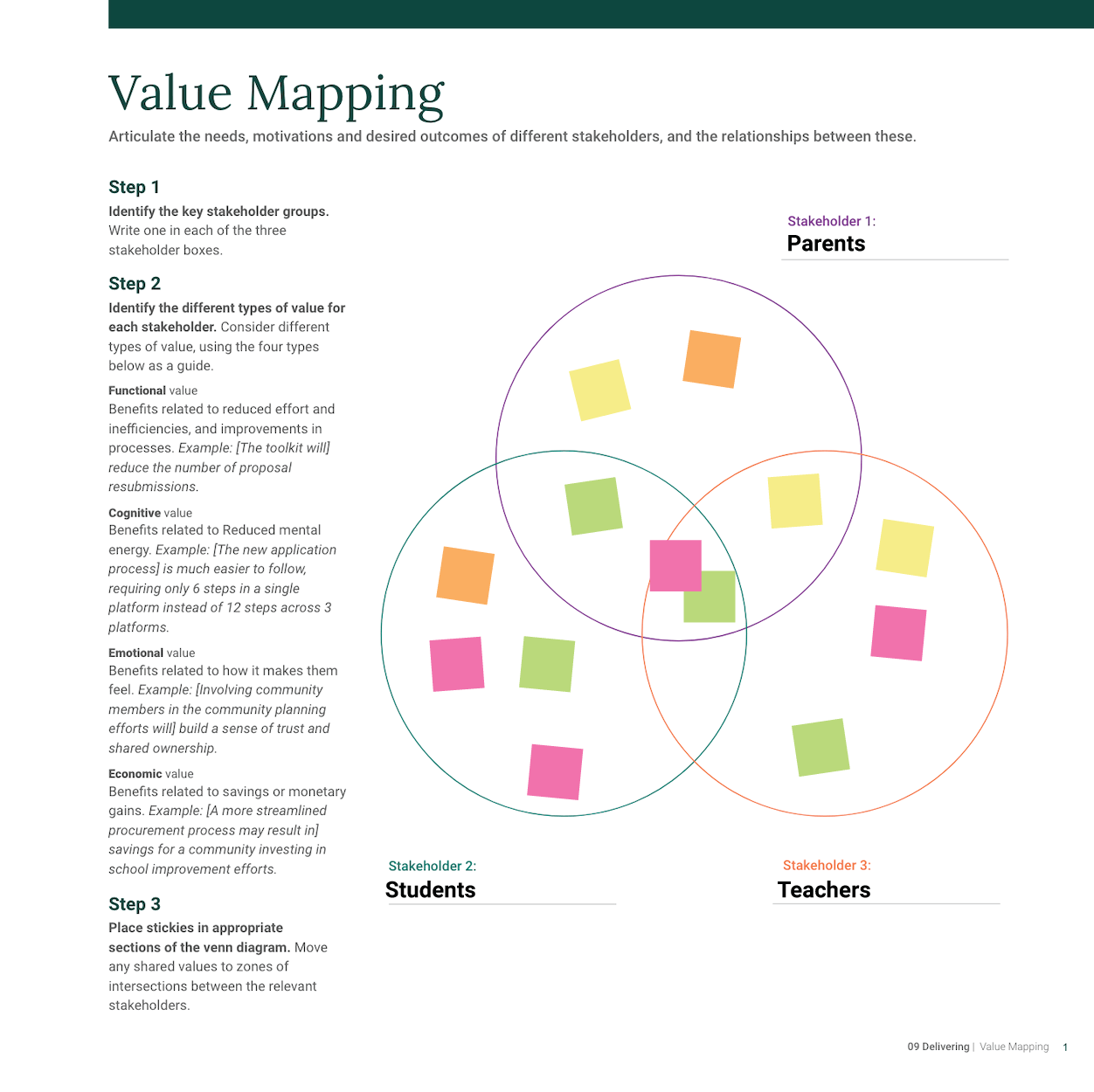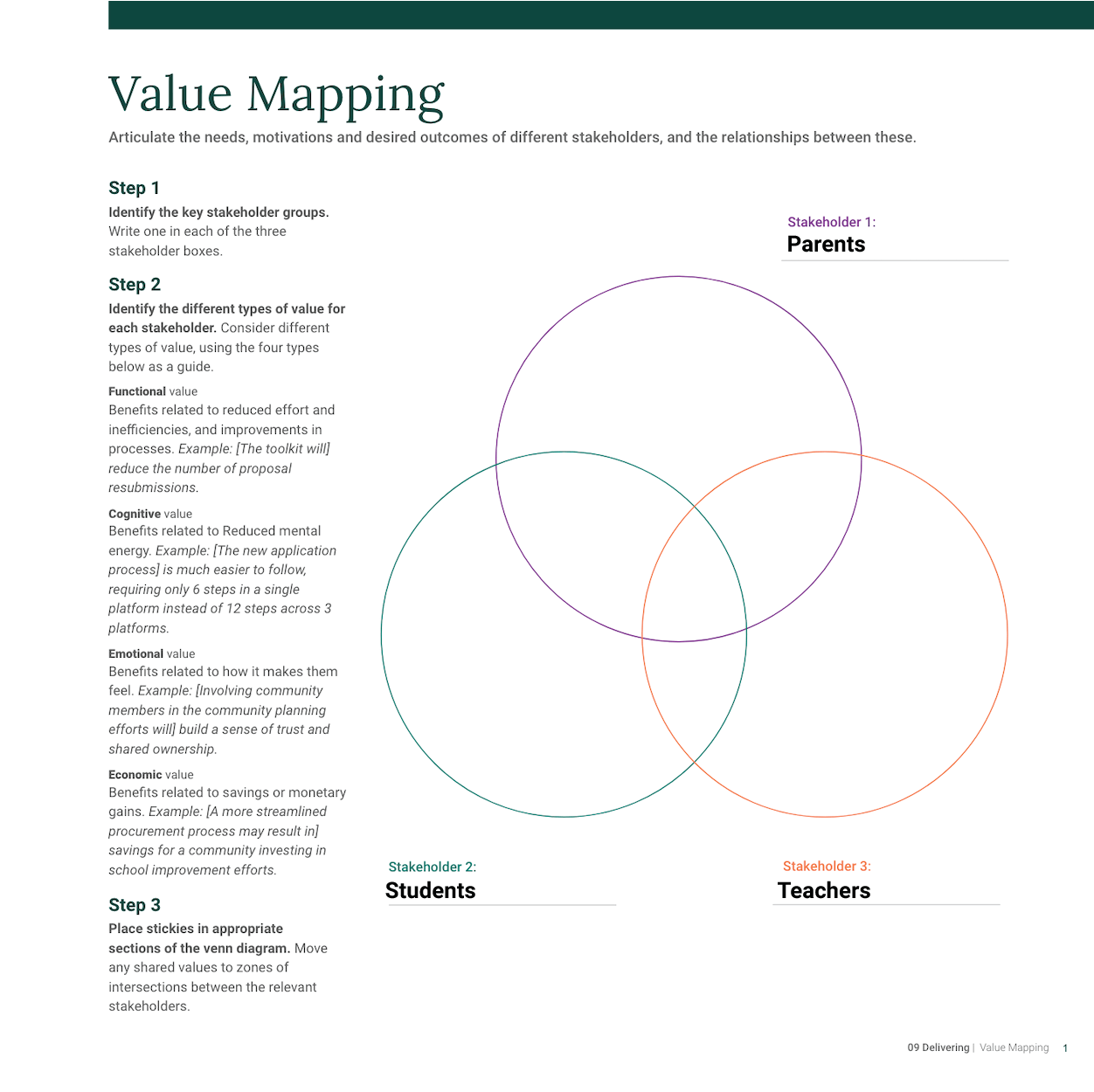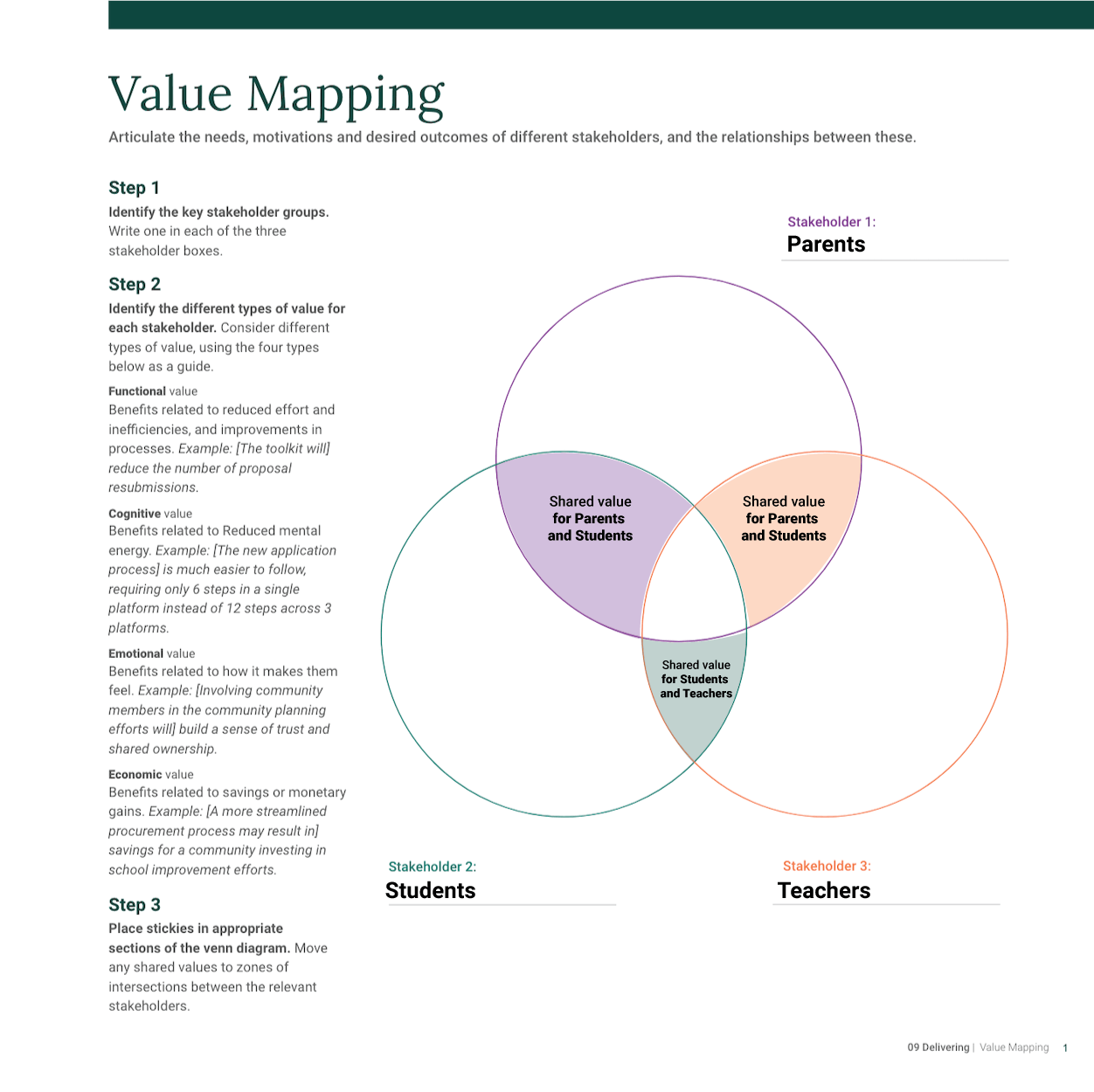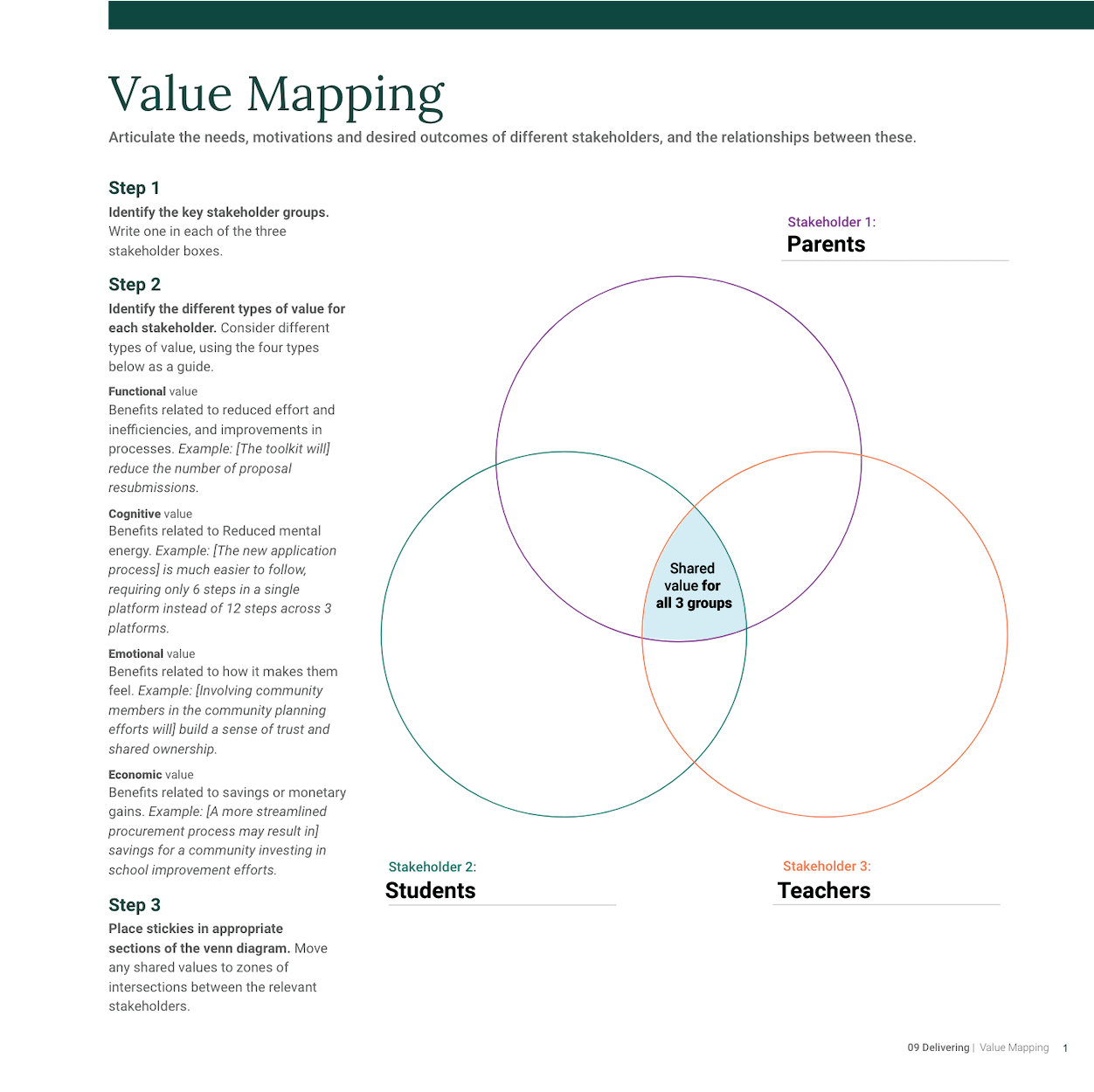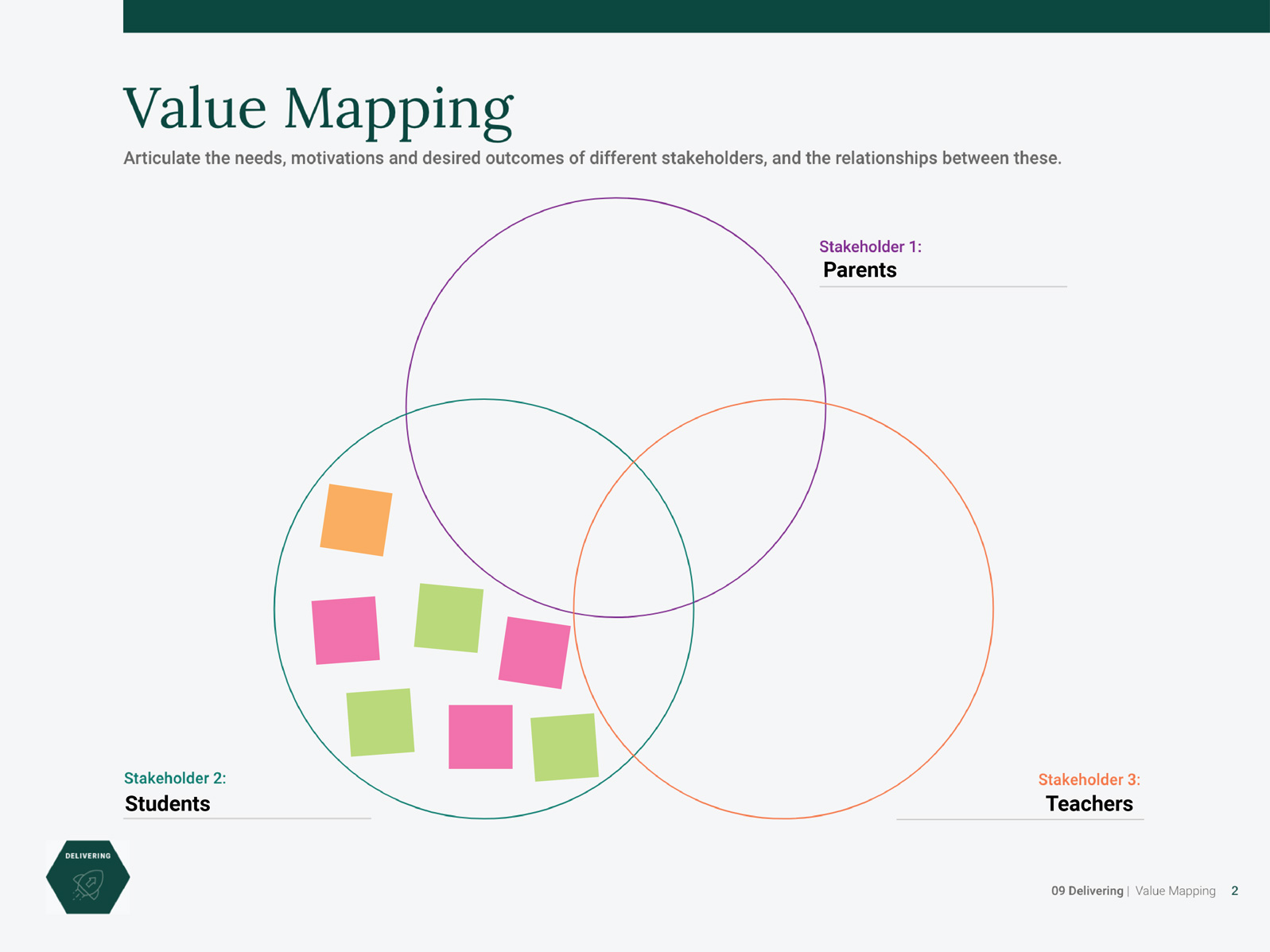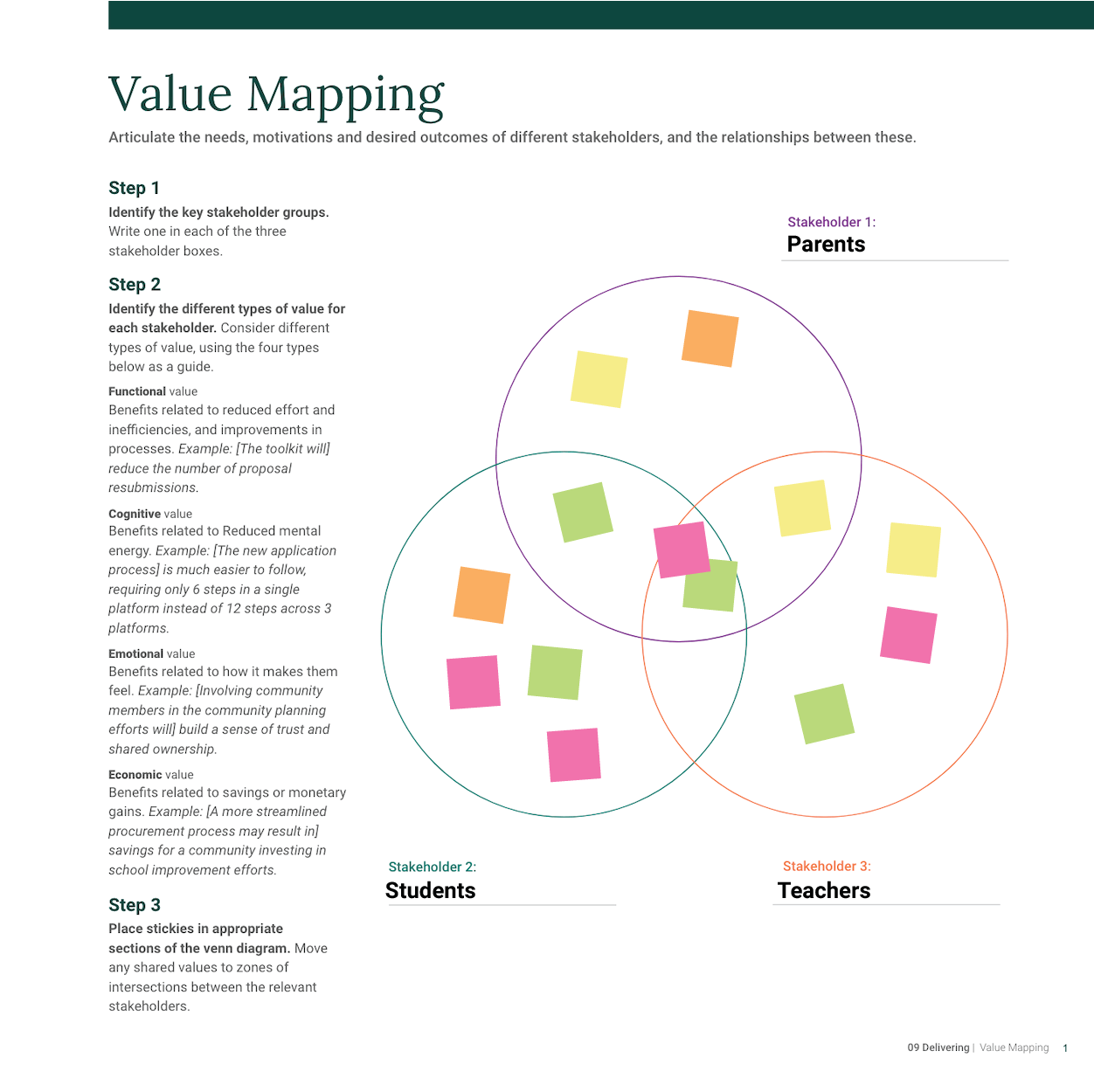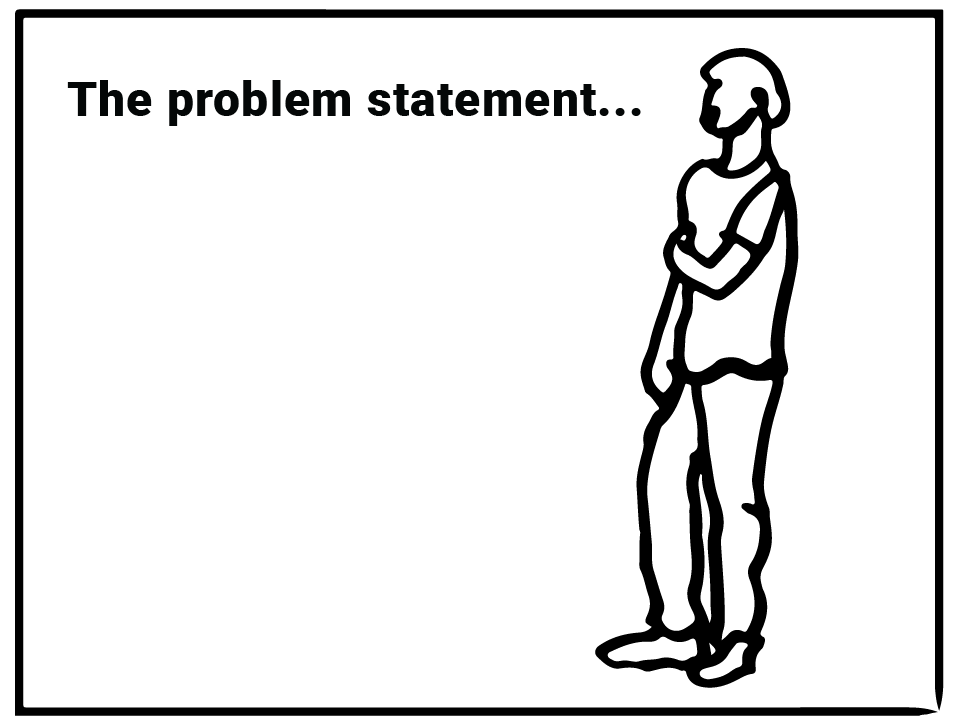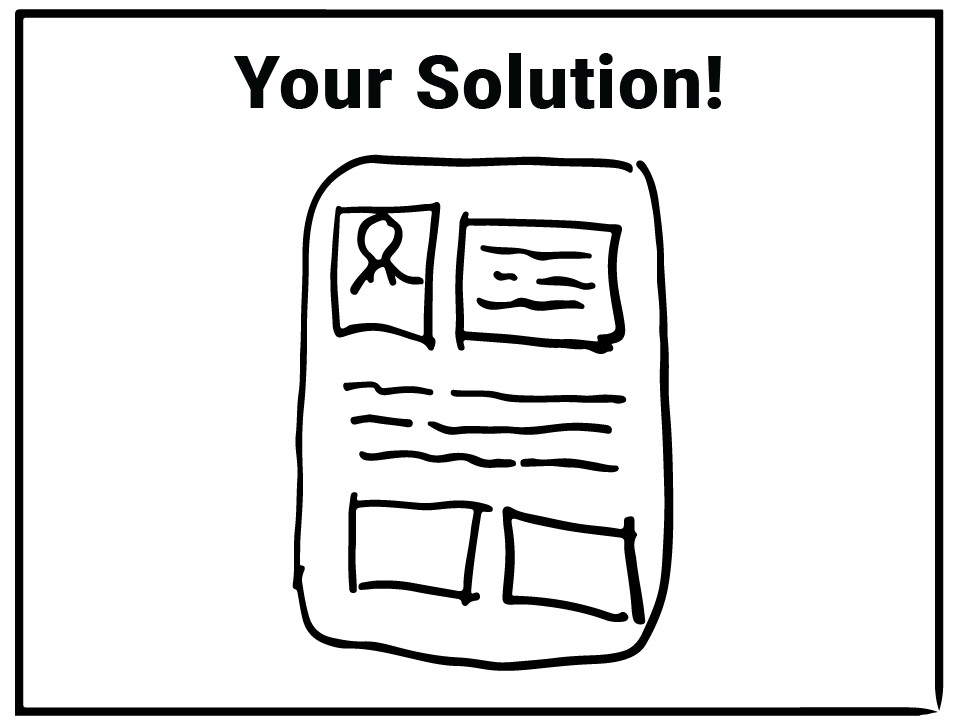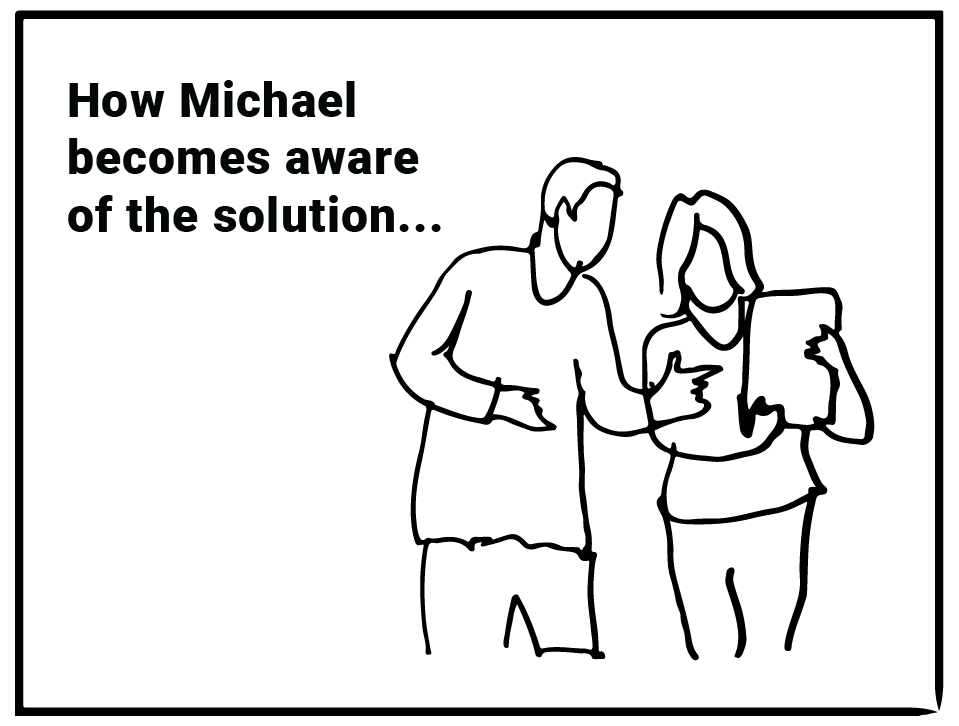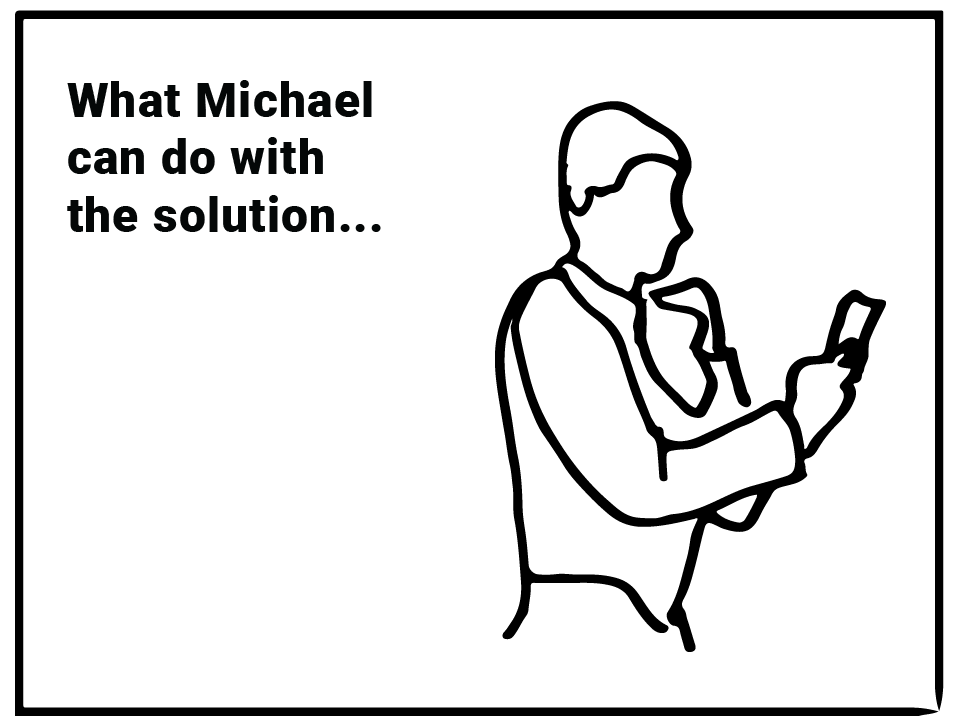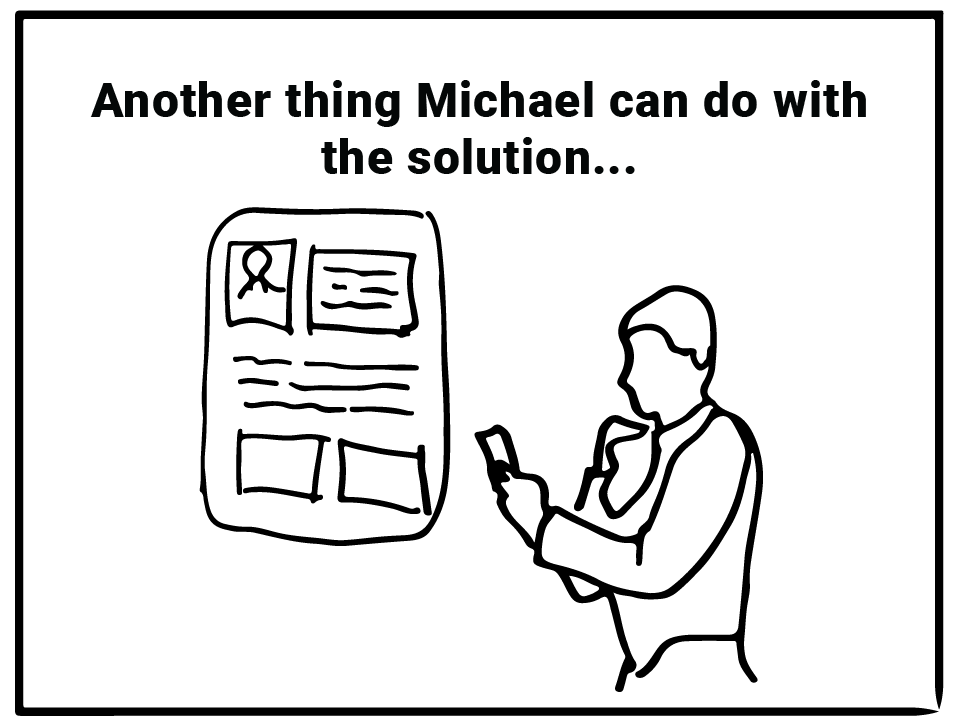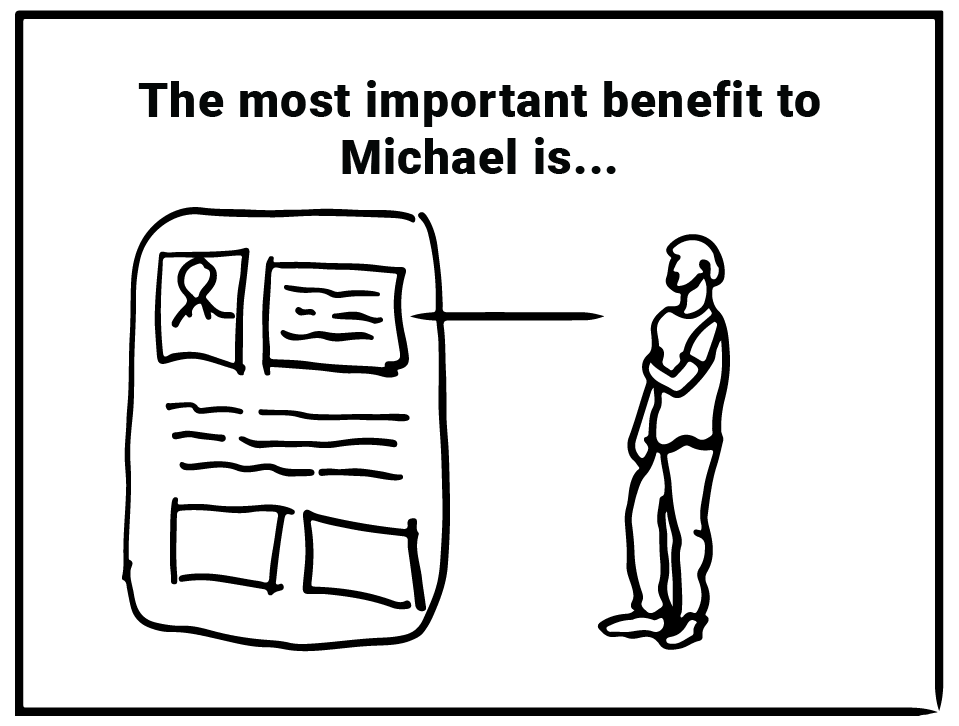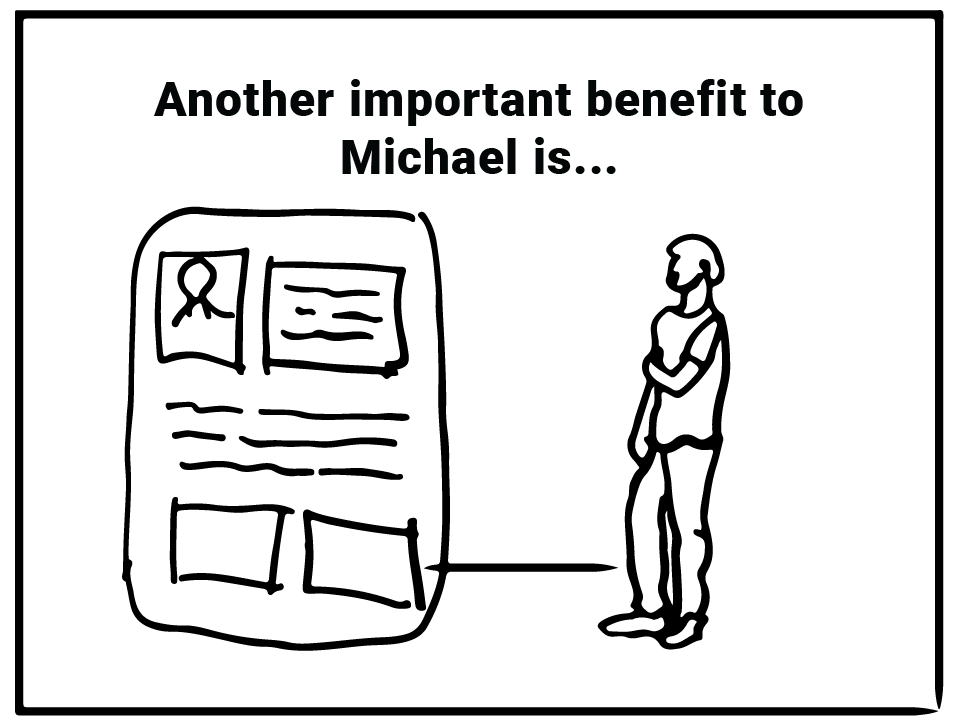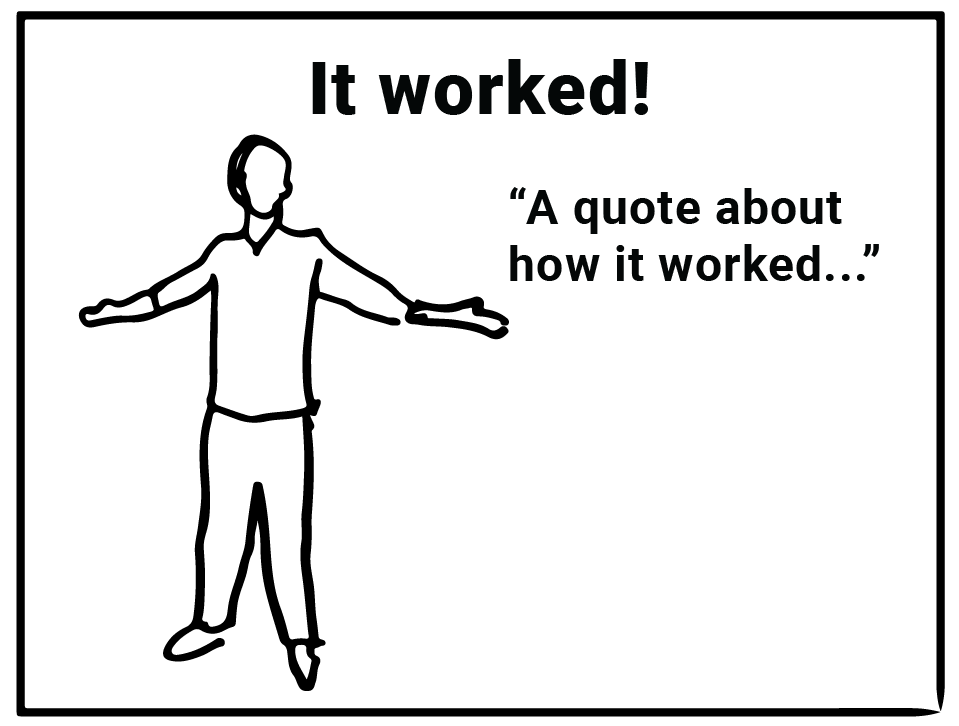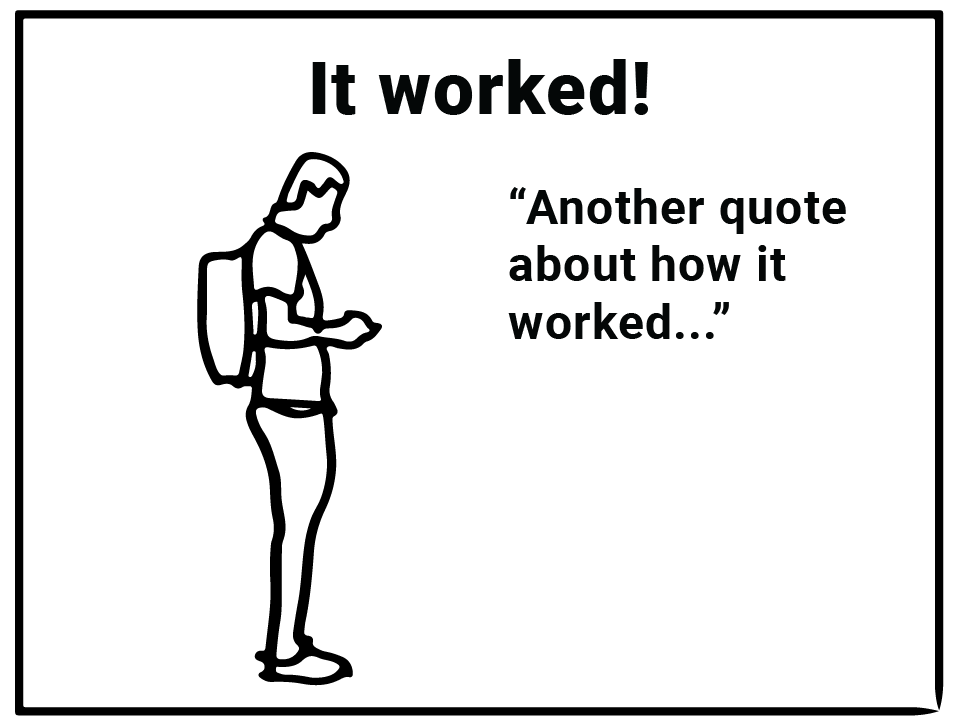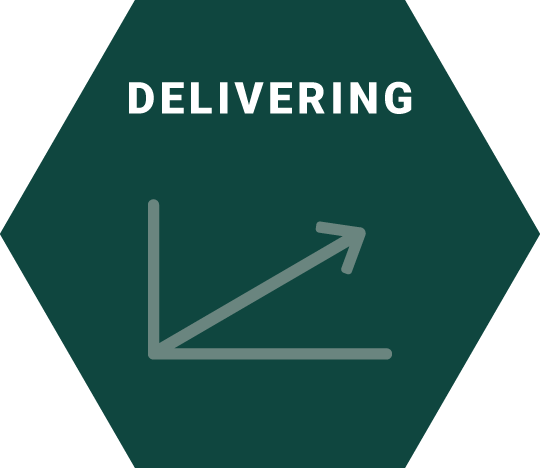
What is Delivering?
Delivering activities are aimed to set teams up for success through the delivery or implementation of solutions. This module will help you gain a firm understanding of the value of your solution for different stakeholders, build support and momentum for your solution by communicating this value, and develop action-oriented plans to ensure the project stays on track.
Why is it important?
Delivering helps you move from concept to reality. It is an important time to demonstrate the impact of your solution and establish a clear pathway for getting your solution off the ground. Earning support and setting up a plan will break a complex effort into manageable tasks.
Methods
- Workstream Preparation: Agree to roles, responsibilities and rules of engagement for implementation of different work streams in the plan.
- Value Mapping: Articulate the desired outcomes of different stakeholders and the relationships between them.
- Communicating through Storytelling: Present your proposed solution in an engaging and persuasive way.
- Impact Measurement Framework: Define clear and measurable indicators to track progress towards your intended goals (worksheet only).
Workstream Preparation
Agree to roles, responsibilities and rules of engagement for implementation of different work streams in the plan
Overview
Workstream Preparation helps you turn an idea, concept or prototype into an implementable, scalable solution by defining key milestones, aligning on responsibilities, and identifying specific steps to generate momentum.
By completing the activities in this method, you will establish shared team practices and identify roles and responsibilities. Furthermore, you will have defined critical milestones, the first steps needed to get there, and the people and resources needed to execute the plan.
These documents make up the first draft of your delivery plans. The best delivery plans have these characteristics:
- Articulate the desired aspiration or outcome.
- Identify key milestones and define specific activities.
- Assign leadership, management and accountability for each workstream and the associated activities.
- Detail performance management routines.
- Support stakeholder engagement and communications.
- Consider using the Communicating through Storytelling method in this Delivering module to prepare for this.
- Describe the resources and support required. Will you need any resources that are currently unavailable? If so, consider how you may obtain them. If you need money, what grants or fundraising efforts should you pursue? If you need people or talent, what volunteers or partnerships are available? If you are thinking of implementing new programming, how will you identify the interest or need?
- Anticipate and prepare for risks.
- Flexible to allow for learning and adapting through implementation.
Use the Rules of Engagement worksheet and the Workstream Preparation worksheet as planning tools to develop these delivery plans.
Establish Rules of Engagement
Schedule a kick-off meeting for the project or core team. The project or core team is the group that is leading the work. The project or core team could be an LSC, a CAC, a parent group, a group of teachers, or a team from CPS. This meeting is designed to help you agree to roles and responsibilities, identify critical milestones, and create an initial action plan for meeting those deadlines.
- To plan for the meeting:
Invite the people responsible for driving the solution across the finish line. These people make up the core team. - Have access to a physical or virtual white board, and/or print out or distribute the relevant worksheets to all team members prior to the meeting. It is critical that all team members see what is being recorded in real time. This helps all members stay aware of the commitments and action items being discussed and agreed upon.
A key objective of a kick-off meeting is to complete the Rules of Engagement worksheet:
Begin Workstream Preparation:
Now, align on key milestones, activities, and project owners.Use the Workstream Preparation worksheet to complete this activity.
Keep this worksheet handy during all team meetings moving forward. This can help hold the group accountable and remind you what you are all striving to accomplish and what you have agreed to do.
Review these plans during your weekly or daily team meetings to ensure you are on track. If you get off track, refer to your Rules of Engagement worksheet for guidance on how the group planned to get back on track. It is ok to evolve those plans as needed. Update your Rules of Engagement worksheet if you identify new strategies.
If necessary, add more workstreams to your delivery plans
Some milestones, or even a defined action step, may require an additional delivery plan with specific milestones, dates and owners. Consider this a new workstream, and go through this same exercise with each separate workstream. These sub-workstreams are all working towards the broader outcome of delivering, but you can use these additional delivery plans to get more targeted in your milestones and actions.
Follow the same delivery plan principles to construct these plans. Remember, they should be concrete and specific, define owners, and specify dates.
Value Mapping
Articulate the desired outcomes of different stakeholders, and the relationships between these outcomes
Overview
Community members and leaders need to make informed decisions about which concepts, plans and proposals are going to be the best for their communities. Value Maps can help you demonstrate your concept’s impact to target communities, and show the different types of value created—beyond just the financial.
Conducting a Value Mapping Exercise
Before you start, prepare your materials. This may include stickies, markers, copies of the Value Mapping worksheet, and a virtual or physical white board. Follow these steps to facilitate this activity:
If you have other stakeholder groups who are very important to the success of your project, redo this activity with a different set of three stakeholders. See if you can identify more areas of value that were previously missed.
Use these completed value map(s) to help you consider your audience and key benefits when articulating your concept to stakeholders. The Communicating Through Storytelling method in this Delivering module may help you construct the narrative for sharing these benefits.
This completed map may also help prepare you for pockets of resistance and concern as you implement your delivery plans. Areas where little to no value are created point to those groups most likely to express concern with the initiative.
Communicating Through Storytelling
Presenting your proposed solution in an engaging and persuasive way
Overview
Communicating through effective storytelling will help you secure buy-in for your proposed solution. Through storytelling you describe an experience of your idea so people understand what you’re proposing, how it works, and why they should care about it. Convey a short, compelling narrative that helps visualize new behaviors and outcomes over time as a result of your solution. This is done by combining four key components:
The Problem
The Solution
The Benefits
The Results
DOWNLOAD WORKSHEET
Once you are satisfied with the outline and content of your story, reproduce it in a polished presentation format. This can be physical posters or a digital slide presentation using PowerPoint or Google Slides.
Delivering May Help You:
- Articulate value that cannot be easily measured financially in the short-term, but that may contribute to the medium- and long-term benefit of the community.
- Align the project team and key stakeholders around the value that the solution intends to create for each of them.
- Think broadly about the impact of your solution and consider what your desired goals and outcomes for the solution are.
- Create a clear and practical plan for implementing your solution.
- Measure and evaluate whether you are on track and establish strategies for getting back on track when unexpected situations arise.
Risk of Not Doing This:
- Fail to secure buy-in from key people.
- Underestimate the resources needed for successful delivery.
- Lack of clarity around initiatives, responsibilities, and actions may lead to stalled delivery or confusion about how to move forward.
- Unclear goals and milestones fail to motivate people and drive momentum.
- Good ideas are put on the shelf and never implemented.
Recommended Inputs:
-
Stakeholder analysis from Framing and insights from Sense Making to help you articulate your solution’s value to different people.
-
Concepts from Prototyping to showcase early versions of the proposed solution.
Do's
- Determine the impact goals of your solution. These high-level goals are what you will use to evaluate and measure your solution against. Each indicator of success should ultimately reinforce your goals.
- Include dates and owners for each action in the delivery plan.
- Consider your audience when communicating your solution. You may need to vary the way you tell the story of your solution depending on the receiving audience. For example, school administrators might want to know more tactical details such as what the timeline and proposed budget are, while a parent might be more focused on how your solution will impact their child’s everyday life.
- Use emotion to convey the value of your solution. People respond best to stories that make them feel something. These will be the most memorable problems and solutions, and most likely to garner support.
- Create a communication that can speak for itself. You may not be there to present your solution to every stakeholder, therefore it is critical that your story is easy to comprehend without an extensive explanation. This could take the form of a storyboard, a brochure, or a video. Whatever you choose, make sure that it speaks for itself.
Don'ts
- Do not create a plan that simply looks good on a shelf. Action plans should be a useful source of clarity and guidance for everyone involved in delivery.
- Do not give your plan superficial treatment and say “We are already doing this”. Be definitive about concrete actions that can be taken to move towards your defined outcome.
- Do not sweat the details of each task. It is easy to get bogged down and overwhelmed with all of the details associated with executing a task in a work plan. Focus on the next action and keep moving forward.
- Do not bury your solution deep in a presentation. When communicating your solution, start with an emotional story, then introduce the concept. More details about the problem will become clear as you discuss the benefits.
- Do not include every single detail about your solution when communicating it to stakeholders. Remember, the purpose of storytelling is to provide a summary of your solution and persuade people to support it.
- Do not give up when momentum slows. It is highly likely that you will experience unforeseen roadblocks and setbacks. Don’t let these discourage you.
- Do not describe the problems as “impossible”. Break each problem into a series of smaller steps.
Documentation Tips:
- Develop a discipline to check in with the team and record progress frequently, and assign someone the role of keeping track. One way of doing this is a SCRUM or Stand-up meeting, a widely adopted practice from the field of Agile software development. This is a 10 to 30-minute meeting at the start of each day or week, depending on how often the team needs to meet to report progress. It is called a Stand-up because everyone is standing on their feet - even if the meeting is virtual - with the intention of keeping it short and focused on removing barriers to progress. It can be documented by creating a table with three prompts (see sub-bullets below) as columns and the names of the team members as rows. During a Stand-up meeting, each team member provides a 1 to 2-minute update following three prompts, such as these:
- “Since the last Stand-up, I have…”
- “Before the next Stand-up, I will…”
- “What’s slowing me down is…”
- Keep detailed notes of comments and feedback you receive when presenting your solution to stakeholders. You may even want to record your conversations so that you have a record of any feedback provided.
- Store all delivering materials in a shared drive for whole team access.
